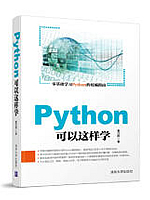给网友朋友们带来一篇相关的编程文章,网友蓬兴德根据主题投稿了本篇教程内容,涉及到pandas行列获取、pandas获取行列、pandas行列获取相关内容,已被463网友关注,如果对知识点想更进一步了解可以在下方电子资料中获取。
pandas行列获取
DataFrame的行和列:df[‘行’, ‘列’]
DataFrame行和列的获取分三个维度
- 行和列选取:df[],一次只能选取行或列
- 区域选取:df.loc[], df.iloc[], df.ix[],可以同时为行或列设置筛选条件
- 单元格选取:df.at[], df.iat[],准确选取某个单元格
先随机生成一个dataframe
import numpy as np
import pandas as pd
df = pd.DataFrame(np.random.randn(10,5), index=list('abcdefghij'), columns=list('ABCDE'))
# Output
A B C D E
a 0.299206 -0.383297 -0.931467 -0.591609 -1.131105
b 0.074351 0.791849 1.637467 -1.408712 -1.376527
c -0.359802 -2.049489 -0.615742 -1.953994 0.685243
d 0.232557 1.768284 -0.447015 2.373358 1.220536
e -0.997380 -0.447236 0.632368 -0.352590 -0.064736
f -1.220178 -0.314304 1.202184 0.018326 1.072153
g -1.508916 0.380466 0.359506 -0.742657 -0.373764
h 1.031420 -3.236676 0.444769 1.396802 -0.405590
i 0.166133 -0.051614 -0.146943 0.609431 -0.351814
j 1.857521 -0.159101 0.899745 1.108722 -0.6153791. 行和列的获取
1.1 根据索引获取行
获取前3行数据
df[:3]
# Output
A B C D E
a 0.299206 -0.383297 -0.931467 -0.591609 -1.131105
b 0.074351 0.791849 1.637467 -1.408712 -1.376527
c -0.359802 -2.049489 -0.615742 -1.953994 0.685243
获取第2到3行数据
df[1:3] # 前闭后开
df['b':'c'] # # 前闭后闭
# Output
A B C D E
b 0.074351 0.791849 1.637467 -1.408712 -1.376527
c -0.359802 -2.049489 -0.615742 -1.953994 0.685243
获取特定行数据
# 布尔数组 (数组长度需等于行数)
df[[True,False,True,False,False,False, True, True, False, True]]
# Output
A B C D E
a 0.299206 -0.383297 -0.931467 -0.591609 -1.131105
c -0.359802 -2.049489 -0.615742 -1.953994 0.685243
g -1.508916 0.380466 0.359506 -0.742657 -0.373764
h 1.031420 -3.236676 0.444769 1.396802 -0.405590
j 1.857521 -0.159101 0.899745 1.108722 -0.615379
1.2 根据条件获取行
获取A列大于0的行
df[df.A > 0]
# Output
A B C D E
a 0.299206 -0.383297 -0.931467 -0.591609 -1.131105
b 0.074351 0.791849 1.637467 -1.408712 -1.376527
d 0.232557 1.768284 -0.447015 2.373358 1.220536
h 1.031420 -3.236676 0.444769 1.396802 -0.405590
i 0.166133 -0.051614 -0.146943 0.609431 -0.351814
j 1.857521 -0.159101 0.899745 1.108722 -0.615379
获取A列和B列大于0的行
df[(df.A > 0) & (df.B > 0)]
# Output
A B C D E
b 0.074351 0.791849 1.637467 -1.408712 -1.376527
d 0.232557 1.768284 -0.447015 2.373358 1.220536
获取A列或列大于0的行
df[(df.A > 0) | (df.B > 0)]
# Output
A B C D E
a 0.299206 -0.383297 -0.931467 -0.591609 -1.131105
b 0.074351 0.791849 1.637467 -1.408712 -1.376527
d 0.232557 1.768284 -0.447015 2.373358 1.220536
g -1.508916 0.380466 0.359506 -0.742657 -0.373764
h 1.031420 -3.236676 0.444769 1.396802 -0.405590
i 0.166133 -0.051614 -0.146943 0.609431 -0.351814
j 1.857521 -0.159101 0.899745 1.108722 -0.615379
1.3 获取列
# 获取A列 df['A'] # 输出为Series类型 df[['A']] # 输出为DataFrame类型 # 获取A列和B列 df[['A', 'B']] df[df.columns[0:2]]
2. 区域选取
- df.loc[] 只能使用标签索引,不能使用整数索引,通过便签索引切边进行筛选时,前闭后闭。
- df.iloc[] 只能使用整数索引,不能使用标签索引,通过整数索引切边进行筛选时,前闭后开。
- df.ix[]既可以使用标签索引,也可以使用整数索引。
2.1 df.loc[]
2.1.1 行选取
获取a行
# 输出为Series类型 df.loc['a'] df.loc['a', :] # Output A 0.299206 B -0.383297 C -0.931467 D -0.591609 E -1.131105 Name: a, dtype: float64 # 输出为DataFrame类型 df.loc[['a']] df.loc[['a'], :] # Output A B C D E a 0.299206 -0.383297 -0.931467 -0.591609 -1.131105
获取a, b, d行
# 使用标签索引
df.loc[['a', 'b', 'd']]
df.loc[['a', 'b', 'd'], :]
# 使用布尔数组
df[[True, True, False, True, False, False, False, True, False, True]]
# Output
A B C D E
a 0.299206 -0.383297 -0.931467 -0.591609 -1.131105
b 0.074351 0.791849 1.637467 -1.408712 -1.376527
d 0.232557 1.768284 -0.447015 2.373358 1.220536
获取a到d行
df.loc['a':'d', :]
# Output
A B C D E
a 0.299206 -0.383297 -0.931467 -0.591609 -1.131105
b 0.074351 0.791849 1.637467 -1.408712 -1.376527
c -0.359802 -2.049489 -0.615742 -1.953994 0.685243
d 0.232557 1.768284 -0.447015 2.373358 1.220536
选取A列大于0的行
df.loc[df.A > 0]
df.loc[df.A > 0, :]
# Output
A B C D E
a 0.299206 -0.383297 -0.931467 -0.591609 -1.131105
b 0.074351 0.791849 1.637467 -1.408712 -1.376527
d 0.232557 1.768284 -0.447015 2.373358 1.220536
h 1.031420 -3.236676 0.444769 1.396802 -0.405590
i 0.166133 -0.051614 -0.146943 0.609431 -0.351814
j 1.857521 -0.159101 0.899745 1.108722 -0.615379
2.1.2 列选取
# 选取A列 df.loc[:, 'A'] # 选取A列和C列 df.loc[:, ['A', 'C']] # 选取A列到C列 df.loc[:, 'A':'C']
2.1.3 同时选取行和列
# 选取c行B列的值 df.loc['c', 'B'] # 选取A列和B列同时大于0的C列和D列 df.loc[((df.A > 0) & (df.B > 0)), ['C', 'D']]
2.1.4 行和列的赋值
# 令a行为10 df.loc['a', :] = 10 # 令B列为50 df.loc[:, 'B'] = 50 # 令b, c行的C到F列为30 df.loc[['b', 'c'], 'C':'F'] = 30 # 令C列小于0的行赋值为0 df.loc[df.C < 0] = 0
2.1.5 多重索引
Example
tuples = [
('cobra', 'mark i'), ('cobra', 'mark ii'),
('sidewinder', 'mark i'), ('sidewinder', 'mark ii'),
('viper', 'mark ii'), ('viper', 'mark iii')
]
index = pd.MultiIndex.from_tuples(tuples)
values = [[12, 2], [0, 4], [10, 20],
[1, 4], [7, 1], [16, 36]]
df = pd.DataFrame(values, columns=['max_speed', 'shield'], index=index)
# Output
df
max_speed shield
cobra mark i 12 2
mark ii 0 4
sidewinder mark i 10 20
mark ii 1 4
viper mark ii 7 1
mark iii 16 36df.loc['cobra']
max_speed shield
mark i 12 2
mark ii 0 4
# return a Series
df.loc[('cobra', 'mark ii')]
max_speed 0
shield 4
Name: (cobra, mark ii), dtype: int64
# return a dataframe
df.loc[[('cobra', 'mark ii')]]
max_speed shield
cobra mark ii 0 4# return a Series df.loc['cobra', 'mark i'] max_speed 12 shield 2 Name: (cobra, mark i), dtype: int64
df.loc[('cobra', 'mark i'), 'shield']
df.loc[('cobra', 'mark i'):'viper']
max_speed shield
cobra mark i 12 2
mark ii 0 4
sidewinder mark i 10 20
mark ii 1 4
viper mark ii 7 1
mark iii 16 36
df.loc[('cobra', 'mark i'):('viper', 'mark ii')]
max_speed shield
cobra mark i 12 2
mark ii 0 4
sidewinder mark i 10 20
mark ii 1 4
viper mark ii 7 12.2 df.iloc[ ]
2.2.1 行选取
选取第二行
# return a Series df.iloc[1] df.iloc[1, :] # return a dataframe df.iloc[[1]] df.iloc[[1], :]
选取前三行
df.iloc[:3, :] df.iloc[:3]
选取第一、三、五行
df.iloc[[1, 3, 5]] df.iloc[[1, 3, 5], :]
2.2.2 列选取
选取第二列
df.iloc[:, 1]
选取前三列
df.iloc[:, 0:3] df.iloc[:,:3]
选取第一三四列
df.iloc[:, [0, 2, 3]]
2.2.3 同时选取行和列
选取第一行第二列的值
df.iloc[0, 1]
选取第二三行的第二到四列
df.iloc[[1,2], 1:4]
2.3 df.ix[ ]
可以混合标签索引和整数索引
However, when an axis is integer based, ONLY label based access and not positional access is supported. Thus, in such cases, it’s usually better to be explicit and use .iloc or .loc.
3. 单元格选取
- df.at[ ] 只能使用标签索引
- df.iat[ ] 只能使用整数索引
3.1 df.at[]
获取c行C列的值
df.at['c', 'C']
把c行C列赋值为10
df.at['c', 'C'] = 10
3.2 df.iat[]
获取第三行第三列的值
df.iat[2, 2]
把第三行第三列赋值为10
df.iat[2, 2] = 10
到此这篇关于pandas行和列的获取的实现的文章就介绍到这了,更多相关pandas行列获取内容请搜索码农之家以前的文章或继续浏览下面的相关文章希望大家以后多多支持码农之家!








